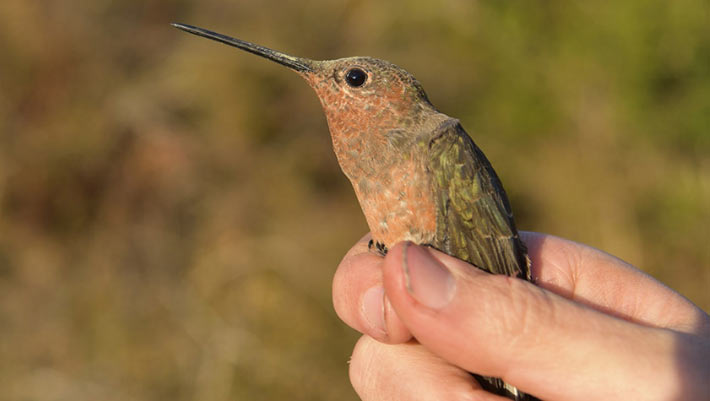The northern population of the giant hummingbird (Patagona gigas) stays in the high Andes year-round while the southern population migrates from sea level up to 4,200 m (14,000 feet) for the nonbreeding months, according to a paper published in the Proceedings of the National Academy of Sciences. The two species appear identical, but their genomes and behaviors tell a different story.
The southern giant hummingbird (Patagona gigas). Image credit: Chris Witt.
The giant hummingbird of western South America is the world’s largest hummingbird.
This species breeds across 39° of latitude and over 4,400 m (14,400 feet) of elevation, but this is not the only way in which this hummingbird seems to bend the rules of life.
It is the most distinct hummingbird, having evolved on its own branch for 14 million years.
It evolved massive size (17 to 31 g), approximately twice as large as the next largest hummingbird, rendering its hovering, nectivorous lifestyle biomechanically and energetically improbable.
At tropical latitudes, giant hummingbirds reside year-round in the high Andes; however, southern temperate populations breed at sea level and embark on a mysterious migration during the austral winter.
In 1834, Charles Darwin witnessed their spring arrival from the ‘parched deserts of the north,’ a reference to the Atacama Desert of northern Chile.
Ornithologists have since hypothesized that the nonbreeding range might include the Andes of southeastern Bolivia or northwestern Argentina, but the migratory journey and nonbreeding range have remained unknown, in part due to the technical challenges of tracking lightweight species.
Dr. Jessie Williamson from the University of New Mexico and Cornell Lab of Ornithology and colleagues wanted to figure out where these migratory giant hummingbirds spend the winter.
By affixing miniature backpacks tracking devices to hummingbirds, they discovered that migratory giant hummingbirds ascend over 4,000 m (13,000 feet) in elevation to the high Andes, flying as far north as the mountains of Peru.
This roundtrip migratory journey covers more than 8,400 km (5,200 miles) — about the distance between New York City and Buenos Aires.
“It took a lot of trial and error to come up with a suitable harness design,” Dr. Williamson said.
“Hummingbirds are challenging to work with because they are lightweight with long wings and short legs. They’re nature’s tiny acrobats.”
One of the team’s discoveries was that migratory giant hummingbirds don’t just fly straight up to high altitudes — they pause their upward climb for periods of days to allow their blood and lungs to acclimate.
In this way, the giant hummingbirds employ the same acclimatization strategy used by human mountaineers.
“Nobody had figured out where migratory giant hummingbirds go because they were hiding among the non-migratory giant hummingbirds,” said University of New Mexico’s Professor Christopher Witt.
“The two forms of giant hummingbird look almost identical — for centuries, ornithologists and birders never noticed that they were different.”
“We couldn’t have figured this out without the miniaturized trackers.”
Genome sequencing of museum specimens allowed the team to distinguish the two forms of giant hummingbirds for the first time.
“Natural history collections were absolutely essential to this work,” said Ethan Gyllenhaal, a Ph.D. candidate at the University of New Mexico.
“Including DNA from 154-year-old type specimens was key to solving this evolutionary puzzle.”
In fact, these valuable historic specimens led the authors to the groundbreaking finding that the migratory and high-elevation resident giant hummingbirds had been evolving separately for about 3 million years, more than enough time to make them distinct species.
The giant hummingbird population that lives year-round in the high Andes is larger and has notably different blood and lungs than the migratory form.
The researchers are proposing straightforward common names: northern giant hummingbird and southern giant hummingbird.
The southern migrant species will retain the name Patagona gigas. The proposed scientific name for the resident northern population is Patagona chaski.
“We have to figure out where these two forms come together and how they interact,” Professor Witt said.
“Do they compete, is one dominant over the other, how might they partition resources, and do they mix or spatially segregate within the winter range? Lots of interesting questions to pursue!”
“I’m really interested in how southern giant hummingbirds make such dramatic shifts in elevation during migration. They travel from sea level to the high Andes in just a few weeks,” Dr. Williamson said.
“They’re like miniature mountain climbers. How do they change their physiology to facilitate these movements?”
_____
Jessie L. Williamson et al. 2024. Extreme elevational migration spurred cryptic speciation in giant hummingbirds. PNAS 121 (21): e2313599121; doi: 10.1073/pnas.2313599121
>>> Read full article>>>
Copyright for syndicated content belongs to the linked Source : Sci-News.com – https://www.sci.news/biology/patagona-chaski-12928.html
